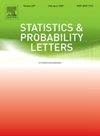低电导图中随机生成树形的抽样
IF 0.7
4区 数学
Q3 STATISTICS & PROBABILITY
引用次数: 0
摘要
在有向图中对随机生成树进行采样对于网络分析、优化和机器学习的应用至关重要。虽然许多最先进的方法在高电导图上表现良好,但它们通常在低电导图上失败或泛化不良。受Wilson算法的启发,我们提出了一种新的采样方法,通过使用动态规划来计算随机游走概率,从而克服了这一限制。这避免了效率低下的行走模拟和数值不稳定的拉普拉斯行列式计算。我们的方法在模拟中显示了优越的效率和采样质量,是唯一一种有效处理低电导图的方法。本文章由计算机程序翻译,如有差异,请以英文原文为准。
Sampling random spanning arborescences in graphs with low conductance
Sampling random spanning arborescences in directed graphs is critical for applications in network analysis, optimization, and machine learning. While many state-of-the-art methods perform well on graphs with high conductance, they often fail or generalize poorly on low-conductance graphs. Inspired by Wilson’s algorithm, we propose a novel sampling approach that overcomes this limitation by using dynamic programming to compute random walk probabilities. This avoids both inefficient walk simulations and numerically unstable Laplacian determinant calculations. Our method demonstrates superior efficiency and sampling quality in simulations, and is the only one to handle low-conductance graphs effectively.
求助全文
通过发布文献求助,成功后即可免费获取论文全文。
去求助
来源期刊

Statistics & Probability Letters
数学-统计学与概率论
CiteScore
1.60
自引率
0.00%
发文量
173
审稿时长
6 months
期刊介绍:
Statistics & Probability Letters adopts a novel and highly innovative approach to the publication of research findings in statistics and probability. It features concise articles, rapid publication and broad coverage of the statistics and probability literature.
Statistics & Probability Letters is a refereed journal. Articles will be limited to six journal pages (13 double-space typed pages) including references and figures. Apart from the six-page limitation, originality, quality and clarity will be the criteria for choosing the material to be published in Statistics & Probability Letters. Every attempt will be made to provide the first review of a submitted manuscript within three months of submission.
The proliferation of literature and long publication delays have made it difficult for researchers and practitioners to keep up with new developments outside of, or even within, their specialization. The aim of Statistics & Probability Letters is to help to alleviate this problem. Concise communications (letters) allow readers to quickly and easily digest large amounts of material and to stay up-to-date with developments in all areas of statistics and probability.
The mainstream of Letters will focus on new statistical methods, theoretical results, and innovative applications of statistics and probability to other scientific disciplines. Key results and central ideas must be presented in a clear and concise manner. These results may be part of a larger study that the author will submit at a later time as a full length paper to SPL or to another journal. Theory and methodology may be published with proofs omitted, or only sketched, but only if sufficient support material is provided so that the findings can be verified. Empirical and computational results that are of significant value will be published.
 求助内容:
求助内容: 应助结果提醒方式:
应助结果提醒方式:


